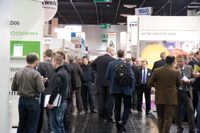|
Radio in hazardous environmentsSelex displayed its intrinsically safe ElettraSuite Puma T3 Plus2 Ex handportable, designed for use in environments containing potentially explosive gas or dust – for example, in the mining, petrochemicals, oil and gas and other industries. Other potential users are in organizations such as fire and rescue services, whose personnel may have to enter hazardous areas. A unique feature is that it can operate not only in TETRA mode but optionally in analogue FM, for interworking with legacy networks, in 12·5?kHz or 25?kHz channels and with CTCSS tone squelch and selective calling. In TETRA mode, the radio offers secure speech and data transmission, with a four-slot data capability for maximum transfer rates. An integrated GPS receiver provides location data and Bluetooth is also included. Secure communication is assured by end-to-end (E2E) encryption and air interface dynamic key encryption. The radio is certified to II 2 G Ex ib IIC T1/T2/T3/T4 and II 3 D Ex tD A22 T85°C IP54. It is supported by a range of chargers and other accessories. Very small and simple to installLatest addition to Cassidian’s range of TETRA base stations is the super-compact TB3P, which weighs a mere 10 kg. “It’s very small, it’s very easy to install”, said Olaf Kaszynski (pictured here). “What you need is only 50 watts, and you can use it in a car. A base station that needs 500 watts is not so easy to use in a car!” Suitable also for providing radio communications indoors or in tunnels, the unit is offered in versions with one, two or four TETRA carriers. RF power output is four watts for the single-carrier version and 1·8 watts with two carriers. “You have two modes for using it”, Mr Kaszynski continues. “If you don’t have a switch, you can use it in solo mode and you can make individual calls, group calls, SDS and other features. And the second mode is the network mode: it is a normal base station and you can use it in any TETRA network and the features are the same as other base stations. No difference. You can use it for TEDS (TETRA Enhanced Data Services) with the same features as the big base stations in TEDS mode. “For the connection to a switch, you can use an E1 connection, you can use an IP connection, and you can use a connection by satellite.” User-friendly IP dispatcher consoleOn Cassidian’s stand, Thomas Ritter demonstrated a fully IP-based radio dispatcher console that can be connected to TETRA radios or TETRA networks or to analogue radio networks. “More important is today the connection to TETRA networks, especially in Germany”, Mr Ritter said. “There’s a couple of features that are mandatory if you want to connect any device to the German digital radio network. You need to have the capability for full end-to-end encryption. For certain emergency calls the console has to behave in a certain way and this console is one of the consoles that is connected to the German BOS digital radio network.” On the touchscreen display can be seen a call log area, listing all radio calls made in recent minutes, including the calling group, identity of the caller and type of call. Below is a message window which shows status reports and enables SDS texts to be sent and received. To the right are the communications functions, including talkgroup selection, in a layout which looks clear and uncluttered. “That was one of the main intentions when we were developing the GUI”, comments Thomas Ritter. “You can configure that user interface completely to the needs of the control room or of the user. It doesn’t need to be done by Cassidian, it can be done by the user itself.” Features to accessIndividual features of the GUI can be locked down so that the operator cannot alter them unless he has sufficient privileges. “As you can see here, I have no ability to move anything”, Mr Ritter says, trying with his mouse. “But now I am logged in as an administrator”, he continues after a moment, “so I can switch to the configuration mode and here I have the ability to move it around, to change it, to rearrange it. I can change the size of the windows and I can completely rearrange the windows. “We have a lot of features that you can access and a lot of possibilities to configure the GUI. And you can have an individual GUI for each operator.” On the adjacent screen is a map display, but Mr Ritter explains that it is much more than that – it is a complete computer-aided dispatch (CAD) system that supports the entire incident-handling process from the initial emergency call onwards. “We have only a small scenario here, but the next step would be to define what has happened. In this case we have a car accident here on the database. You just click and then the system starts to ask you certain questions which you will ask to the citizen. We have injured people? Depending on your answer, yes or no, the priority of the incident will be changed.
|

 With deployment of Germany’s BOSnet system now reaching an advanced stage in the police service and spreading also to other public safety bodies,
With deployment of Germany’s BOSnet system now reaching an advanced stage in the police service and spreading also to other public safety bodies,